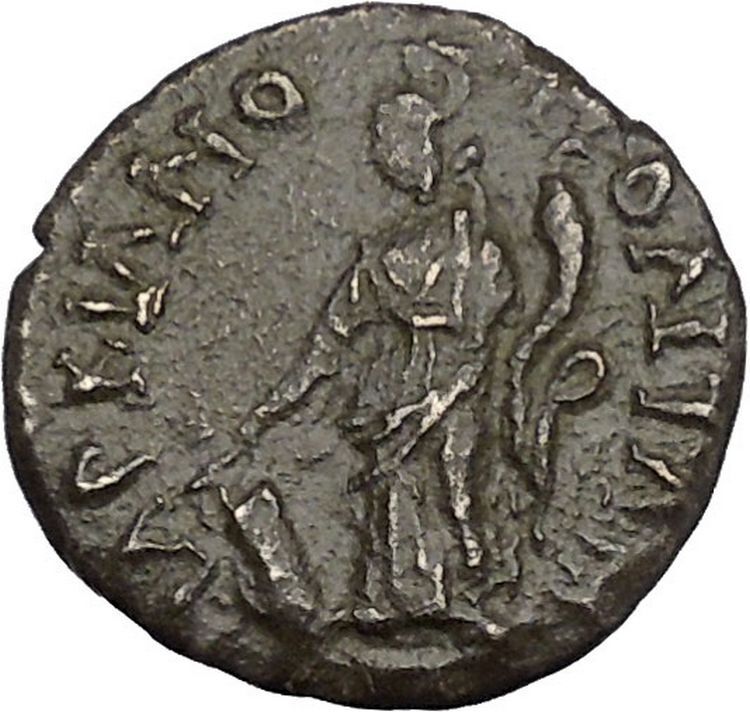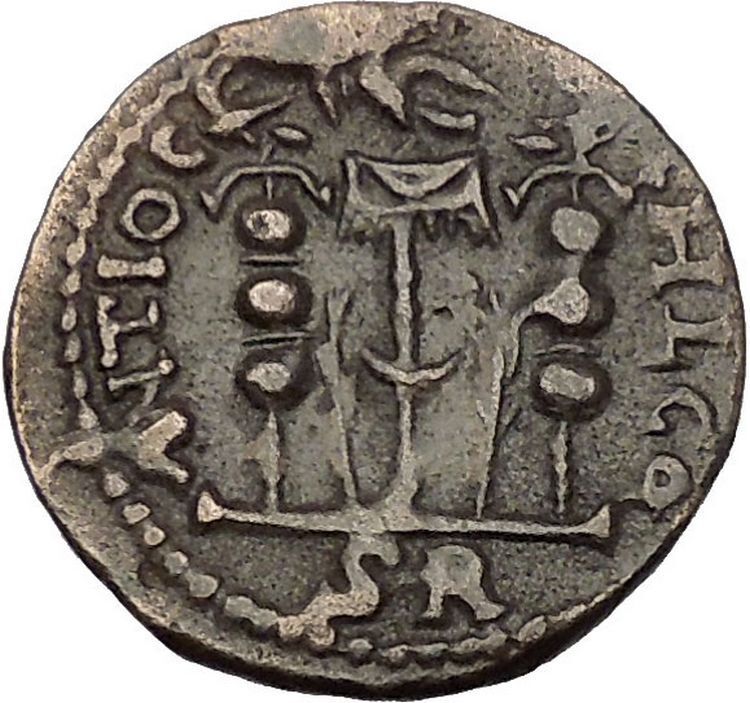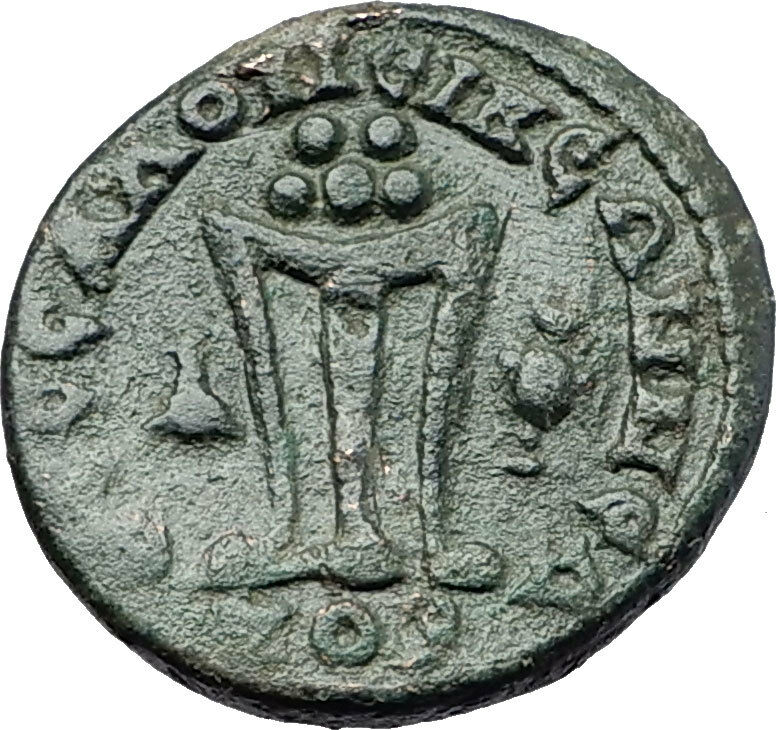|
Elagabalus – Roman Emperor: 218-222 A.D.
Bronze 17mm (3.85 grams) of Nicopolis ad Istrum in Moesia Inferior
AV K M AVP ANTΩNINO, Laureate, draped and cuirassed bust right.
ΝΙΚΟΠΟΛΙΤΩΝ ΠΡΟС ΙСTPON, Serpent-entwined (medicine symbol) staff of Asclepius.
You are bidding on the exact item pictured, provided with a Certificate of Authenticity and Lifetime Guarantee of Authenticity.
.JPG/200px-Statue_of_Asklepios_NAMA_263_(DerHexer).JPG)  Asclepius is the god of medicine and healing in ancient Greek religion. Asclepius represents the healing aspect of the medical arts; his daughters are Hygieia (“Health”), Iaso (“Medicine”), Aceso (“Healing”), and Panacea (“Universal Remedy”). The rod of Asclepius, a snake-entwined staff, remains a symbol of medicine today, although sometimes the caduceus, or staff with two snakes, is mistakenly used instead. He was associated with the Roman/Etruscan god Vediovis. He was one of Apollo’s servants. Asclepius is the god of medicine and healing in ancient Greek religion. Asclepius represents the healing aspect of the medical arts; his daughters are Hygieia (“Health”), Iaso (“Medicine”), Aceso (“Healing”), and Panacea (“Universal Remedy”). The rod of Asclepius, a snake-entwined staff, remains a symbol of medicine today, although sometimes the caduceus, or staff with two snakes, is mistakenly used instead. He was associated with the Roman/Etruscan god Vediovis. He was one of Apollo’s servants.
The rod of Asclepius, also known as the asklepian, is an ancient symbol associated with astrology, the Greek god Asclepius and with medicine and healing. It consists of a serpent entwined around a staff. The name of the symbol derives from its early and widespread association with Asclepius, the son of Apollo, who was a practitioner of medicine in ancient Greek mythology. His attributes, the snake and the staff, sometimes depicted separately in antiquity, are combined in this symbol. The Rod of Asclepius also represents the constellation Ophiuchus (or Ophiuchus Serpentarius), the thirteenth sign of the sidereal zodiac. Hippocrates himself was a worshipper of Asclepius.
Nicopolis ad Istrum was a Roman and Early Byzantine town founded by Emperor Trajan around 101-106, at the junction of the Iatrus (Yantra) and the Rositsa rivers, in memory of his victory over the Dacians. Its ruins are located at the village of Nikyup, 20 km north of Veliko Tarnovo in northern Bulgaria. The town reached its apogee during the reigns of Trajan, Hadrian, the Antonines and the Severan dynasty.
The classical town was planned according to the orthogonal system. The network of streets, the forum surrounded by an Ionic colonnade and many buildings, a two-nave room later turned into a basilica and other public buildings have been uncovered. The rich architectures and sculptures show a similarity with those of the ancient towns in Asia Minor. Nicopolis ad Istrum had issued coins, bearing images of its own public buildings.
In 447 AD, the town was destroyed by Attila’s Huns. Perhaps it was already abandoned before the early 400s. In the 6th century, it was rebuilt as a powerful fortress enclosing little more than military buildings and churches, following a very common trend for the cities of that century in the Danube area.The largest area of the extensive ruins (21.55 hectares) of the classical Nicopolis was not reoccupied since the fort covered only one fourth of it (5.75 hectares), in the southeastern corner. The town became an episcopal centre during the early Byzantine period. It was finally destroyed by the Avar invasions at the end of the 6th century. A Bulgarian medieval settlement arose upon its ruins later (10th-14th century).
Nicopolis ad Istrum can be said to have been the birthplace of Germanic literary tradition. In the 4th century, the Gothic bishop, missionary and translator Ulfilas (Wulfila) obtained permission from Emperor Constantius II to immigrate with his flock of converts to Moesia and settle near Nicopolis ad Istrum in 347-8. There, he invented the Gothic alphabet and translated the Bible from Greek to Gothic.
.jpg/220px-Bust_of_Elagabalus_-_Palazzo_Nuovo_-_Musei_Capitolini_-_Rome_2016_(2).jpg) Elagabalus – Emperor: 218-222 A.D. Elagabalus – Emperor: 218-222 A.D.
Son of Julia Soaemias | Husband of Julia Paula, Aquilia Severa and Annia Faustina | Grandson of Julia Maesa | Nephew of Julia Mamaea | Cousin of Severus Alexander | Second-cousin of Geta and Caracalla (Supposedly a natural son of Caracalla) | Great-nephew of Septimius Severus and Julia Domna |
Elagabalus (Marcus Aurelius Antoninus Augustus, ca. 203 – 11 March 222), also known as Heliogabalus, was Roman Emperor from 218 to 222. A member of the Severan Dynasty, he was Syrian on his mother’s side, the son of Julia Soaemias and Sextus Varius Marcellus. In his early youth he served as a priest of the god Elagabal (in Latin, Elagabalus) in the hometown of his mother’s family, Emesa. As a private citizen, he was probably named Sextus Varius Avitus Bassianus. Upon becoming emperor he took the name Marcus Aurelius Antoninus Augustus. He was called Elagabalus only after his death.
In 217, the emperor Caracalla was assassinated and replaced by his Praetorian prefect, Marcus Opellius Macrinus. Caracalla’s maternal aunt, Julia Maesa, successfully instigated a revolt among the Third Legion to have her eldest grandson (and Caracalla’s cousin), Elagabalus, declared emperor in his place. Macrinus was defeated on 8 June 218, at the Battle of Antioch. Elagabalus, barely fourteen years old, became emperor, initiating a reign remembered mainly for sexual scandal and religious controversy.
Later historians suggest Elagabalus showed a disregard for Roman religious traditions and sexual taboos. He replaced the traditional head of the Roman pantheon, Jupiter, with the deity of whom he was high priest, Elagabal. He forced leading members of Rome’s government to participate in religious rites celebrating this deity, over which he personally presided. Elagabalus was married as many as five times, lavished favors on male courtiers popularly thought to have been his lovers, employed a prototype of whoopee cushions at dinner parties, and was reported to have prostituted himself in the imperial palace. His behavior estranged the Praetorian Guard, the Senate, and the common people alike.
Amidst growing opposition, Elagabalus, just 18 years old, was assassinated and replaced by his cousin Alexander Severus on 11 March 222, in a plot formulated by his grandmother, Julia Maesa, and carried out by disaffected members of the Praetorian Guard.
Elagabalus developed a reputation among his contemporaries for extreme eccentricity, decadence and zealotry. This tradition has persisted, and in writers of the early modern age he suffers one of the worst reputations among Roman emperors. Edward Gibbon, for example, wrote that Elagabalus “abandoned himself to the grossest pleasures and ungoverned fury.” According to B.G. Niebuhr, “The name Elagabalus is branded in history above all others” because of his “unspeakably disgusting life.”
Emperor (218-222)
Elagabalus and his entourage spent the winter of 218 in Bithynia at Nicomedia, where the emperor’s religious beliefs first presented themselves as a problem. The contemporary historian Cassius Dio suggests that Gannys was in fact killed by the new emperor because he was forcing Elagabalus to live “temperately and prudently.” To help Romans adjust to the idea of having an oriental priest as emperor, Julia Maesa had a painting of Elagabalus in priestly robes sent to Rome and hung over a statue of the goddess Victoria in the Senate House. This placed senators in the awkward position of having to make offerings to Elagabalus whenever they made offerings to Victoria.
The legions were dismayed by his behaviour and quickly came to regret having supported his accession. While Elagabalus was still on his way to Rome, brief revolts broke out by the Fourth Legion at the instigation of Gellius Maximus, and by the Third Legion, which itself had been responsible for the elevation of Elagabalus to the throne, under the command of Senator Verus. The rebellion was quickly put down, and the Third Legion disbanded.
When the entourage reached Rome in the autumn of 219, Comazon and other allies of Julia Maesa and Elagabalus were given powerful and lucrative positions, to the outrage of many senators who did not consider them worthy of such privileges. After his tenure as Praetorian prefect, Comazon would serve as the city prefect of Rome three times, and as consul twice. Elagabalus soon devalued the Roman currency. He decreased the silver purity of the denarius from 58% to 46.5% – the actual silver weight dropping from 1.82 grams to 1.41 grams. He also demonetized the antoninianus during this period in Rome.
Elagabalus tried to have his presumed lover, the charioteer Hierocles, declared Caesar, while another alleged lover, the athlete Aurelius Zoticus, was appointed to the non-administrative but influential position of Master of the Chamber, or Cubicularius. His offer of amnesty for the Roman upper class was largely honored, though the jurist Ulpian was exiled.
The relationships between Julia Maesa, Julia Soaemias, and Elagabalus were strong at first. His mother and grandmother became the first women to be allowed into the Senate, and both received senatorial titles: Soaemias the established title of Clarissima, and Maesa the more unorthodox Mater Castrorum et Senatus (“Mother of the army camp and of the Senate”). While Julia Maesa tried to position herself as the power behind the throne and thus the most powerful woman in the world, Elagabalus would prove to be highly independent, set in his ways, and impossible to control.
Fall from power
By 221 Elagabalus’ eccentricities, particularly his relationship with Hierocles, increasingly provoked the soldiers of the Praetorian Guard. When Elagabalus’ grandmother Julia Maesa perceived that popular support for the emperor was waning, she decided that he and his mother, who had encouraged his religious practices, had to be replaced. As alternatives, she turned to her other daughter, Julia Avita Mamaea, and her daughter’s son, the thirteen-year-old Severus Alexander.
Prevailing on Elagabalus, she arranged that he appoint his cousin Alexander as his heir and be given the title of Caesar. Alexander shared the consulship with the emperor that year. However, Elagabalus reconsidered this arrangement when he began to suspect that the Praetorian Guard preferred his cousin above himself.
Following the failure of various attempts on Alexander’s life, Elagabalus stripped his cousin of his titles, revoked his consulship, and circulated the news that Alexander was near death, in order to see how the Praetorians would react. A riot ensued, and the guard demanded to see Elagabalus and Alexander in the Praetorian camp.
Assassination
The emperor complied and on 11 March 222 he publicly presented his cousin along with his own mother, Julia Soaemias. On their arrival the soldiers started cheering Alexander while ignoring Elagabalus, who ordered the summary arrest and execution of anyone who had taken part in this display of insubordination. In response, members of the Praetorian Guard attacked Elagabalus and his mother:
So he made an attempt to flee, and would have got away somewhere by being placed in a chest, had he not been discovered and slain, at the age of 18. His mother, who embraced him and clung tightly to him, perished with him; their heads were cut off and their bodies, after being stripped naked, were first dragged all over the city, then the mother’s body was cast aside somewhere or other while his was thrown into the [Tiber].
Following his assassination, many associates of Elagabalus were killed or deposed, including Hierocles and Comazon. His religious edicts were reversed and the stone of Elagabal was sent back to Emesa. Women were again barred from attending meetings of the Senate. The practice of damnatio memoriae-erasing from the public record a disgraced personage formerly of note-was systematically applied in his case.
|





.JPG/200px-Statue_of_Asklepios_NAMA_263_(DerHexer).JPG)
 Asclepius is the god of medicine and healing in ancient Greek religion. Asclepius represents the healing aspect of the medical arts; his daughters are Hygieia (“Health”), Iaso (“Medicine”), Aceso (“Healing”), and Panacea (“Universal Remedy”). The rod of Asclepius, a snake-entwined staff, remains a symbol of medicine today, although sometimes the caduceus, or staff with two snakes, is mistakenly used instead. He was associated with the Roman/Etruscan god Vediovis. He was one of Apollo’s servants.
Asclepius is the god of medicine and healing in ancient Greek religion. Asclepius represents the healing aspect of the medical arts; his daughters are Hygieia (“Health”), Iaso (“Medicine”), Aceso (“Healing”), and Panacea (“Universal Remedy”). The rod of Asclepius, a snake-entwined staff, remains a symbol of medicine today, although sometimes the caduceus, or staff with two snakes, is mistakenly used instead. He was associated with the Roman/Etruscan god Vediovis. He was one of Apollo’s servants..jpg/220px-Bust_of_Elagabalus_-_Palazzo_Nuovo_-_Musei_Capitolini_-_Rome_2016_(2).jpg) Elagabalus – Emperor: 218-222 A.D.
Elagabalus – Emperor: 218-222 A.D.




